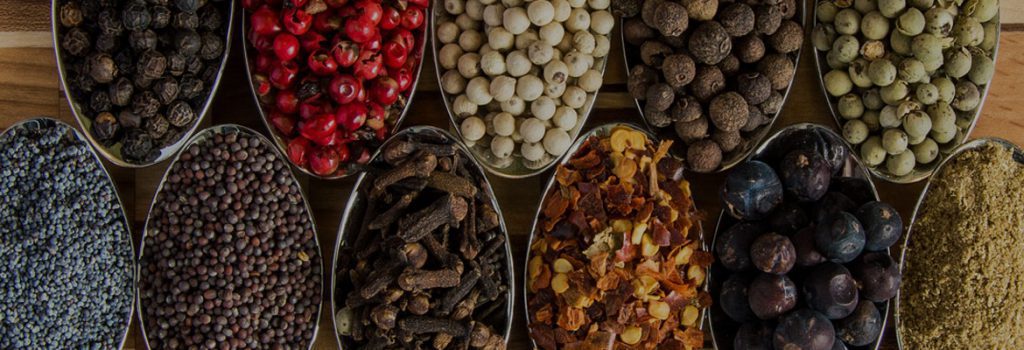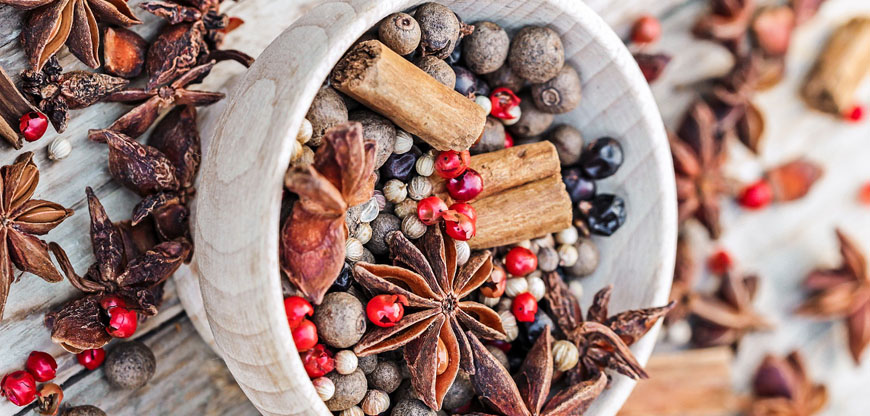Herbs and spices are plant-derived seasonings used for culinary purposes. The terms ‘herbs’ and ‘spices’ are often used interchangeably, but they have specific definitions in botany. Herbs store flavor components in their leaves, whereas spices store theirs in seeds, bark, and root. A spice may be the bud (clove), bark (cinnamon), root (ginger), aromatic seed (cumin), and flower stigma (saffron) of a plant. In addition to making food taste good, culinary spices have been used as food preservatives and for their health-enhancing properties for centuries (Kaefer and Milner, 2011).
The use of spices in culinary predates recorded history and is said to have been an integral part of local dishes in South Asia and the Middle East as far back as 2000 BCE The legendary Christopher Columbus’ explorations in 1492 were in search of herbs and spices. In Mesopotamia, the cradle of civilization where agriculture began, there is evidence that humans were using thyme for their health properties as early as 5000 BC and were growing garlic as early as 3000 BC). Spices are often gathered from plants when they have stopped flowering.
Spices are functional foods, these are foods that can be demonstrated to have a beneficial effect on certain target functions in the body beyond basic nutritional requirements Spices occur in a variety of flavors, colors, and aromas contributing a wide range of nutrients to foods (Mann, 2011). They enhance and complement flavor in foods with no detrimental effect on the organoleptic quality of the food.

Herbs and spices elaborate secondary metabolites that form part of the plants’ chemical defense. They make food taste good but may not be delicious themselves, and many of them possess marked pharmacological and medicinal properties. Their constituents function as defense chemicals to repel insects, snails, and other animals, and to kill microbes especially parasitic fungi They sometimes contain allelochemicals, used by certain plants to inhibit the growth of other plant species around them. The importance of spices is underscored by the fact that they are still found in 40% of drugs prescribed to date.
Spices and herbs are revered for their potential health attributes. They are reported to have positive effects in the treatment of numerous diseases, especially chronic ones such as cancer, diabetes, and cardiovascular diseases That nutrition and health are intricately linked is a well-established fact, and the ability of nutrition (in this case, nutrients from spices) to reduce the risk of diseases has engaged the attention of researchers and nutritionist alike in recent decades. Numerous epidemiological, preclinical, and clinical studies providing insights into the mode of action of this relationship have been carried out.
“Herbs and spices make food tastier while boosting your health,” says Moreno, an adjunct professor of nutrition at the University of Miami and a dietitian for the Miami Marlins. “You should be cooking with herbs and spices regularly — and, if possible, using several at a time.”
Herbs, like basil, are the leaves of a plant, while spices, like cinnamon, are usually made from the seeds, berries, bark, or roots of a plant. Both are used to flavor food, but research shows they’re chock-full of healthy compounds and may have health benefits. “Herbs and spices fight inflammation and reduce damage to your body’s cells,” Moreno says. “That’s because each one is rich in phytochemicals, which are healthful plant chemicals.”
Spices and herbs have been in use for centuries both for culinary and medicinal purposes. Spices not only enhance the flavor, aroma, and color of food and beverages, but they can also protect you from acute and chronic diseases. More Americans are considering the use of spices and herbs for medicinal and therapeutic/remedy use, especially for various chronic conditions. There is now ample evidence that spices and herbs possess antioxidant, anti-inflammatory, antitumorigenic, anticarcinogenic, and glucose- and cholesterol-lowering activities as well as properties that affect cognition and mood.

Research over the past decade has reported on the diverse range of health properties that they possess via their bioactive constituents, including sulfur-containing compounds, tannins, alkaloids, phenolic diterpenes, and vitamins, especially flavonoids and polyphenols. Spices and herbs such as clove, rosemary, sage, oregano, and cinnamon are excellent sources of antioxidants with their high content of phenolic compounds.
It is evident that frequent consumption of spicy foods was also linked to a lower risk of death from cancer and ischemic heart and respiratory system diseases. However, the actual role of spices and herbs in the maintenance of health, specifically with regards to protecting against the development of chronic, non-communicable diseases, is currently unclear. This review highlights the potential health benefits of commonly used spices and herbs such as chili pepper, cinnamon, ginger, black pepper, turmeric, fenugreek, rosemary, and garlic.


